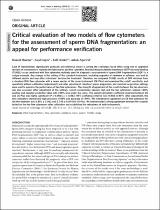| dc.contributor.author | Sharma, Rakesh | |
| dc.contributor.author | Gupta, Sajal | |
| dc.contributor.author | Henkel, Ralf | |
| dc.date.accessioned | 2023-06-06T12:11:38Z | |
| dc.date.available | 2023-06-06T12:11:38Z | |
| dc.date.issued | 2019 | |
| dc.identifier.citation | Sharma, R. et al. (2019). Critical evaluation of two models of flow cytometers for the assessment of sperm DNA fragmentation: an appeal for performance verification. Asian Journal of Andrology, 21 (5) , 438-444. 10.4103/aja.aja_109_18 | en_US |
| dc.identifier.issn | 1745-7262 | |
| dc.identifier.uri | 10.4103/aja.aja_109_18 | |
| dc.identifier.uri | http://hdl.handle.net/10566/9039 | |
| dc.description.abstract | Lack of standardized, reproducible protocols and reference values is among the challenges faced when using new or upgraded
versions of instruments in reproductive laboratories and flow cytometry. Terminal deoxynucleotidyl transferase dUTP nick end labeling
(TUNEL) assay combined with flow cytometry routinely used for diagnostic measurement of sperm DNA fragmentation (SDF) is a
unique example. Any change in the setting of the standard instrument, including upgrades of hardware or software, can lead to
different results and may affect clinicians’ decision for treatment. Therefore, we compared TUNEL results of SDF obtained from
a standard (C6) flow cytometer with a newer version of the same instrument (C6 Plus) and examined the cutoff, sensitivity, and
specificity without calibration (adjustment) and after adjustment. Identical sperm preparation and matched acquisition settings
were used to examine the performance of two flow cytometers. The strength of agreement of the results between the two observers
was also assessed. After adjustment of the settings, overall concordance became high and the two cytometers showed 100%
positive and negative predictive value with 100% area under the curve. The overall correlation coefficient observed between C6
and C6 Plus was highly significant (P < 0.0001; r = 0.992; 95% confidence interval [CI]: 0.982–0.997). After adjustment, the
two cytometers showed very high precision of 98% and accuracy of >99%. The interobserver agreement on C6 flow cytometer for
the two observers was 0.801 ± 0.062 and 0.746 ± 0.044 for C6 Plus. We demonstrated a strong agreement between the samples
tested on the two flow cytometers after calibration and established the robustness of both instruments. | en_US |
| dc.language.iso | en | en_US |
| dc.publisher | Medknow Publications | en_US |
| dc.subject | DNA fragmentation | en_US |
| dc.subject | Bioscience | en_US |
| dc.subject | Sperm | en_US |
| dc.subject | Oxidative stress | en_US |
| dc.title | Critical evaluation of two models of flow cytometers for the assessment of sperm DNA fragmentation: an appeal for performance verification | en_US |
| dc.type | Article | en_US |

